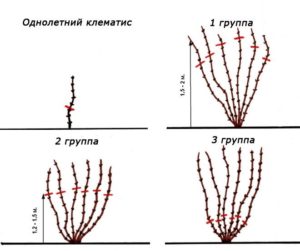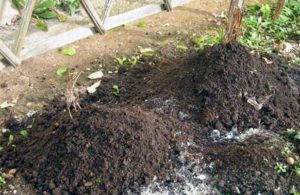How to care for clematis in the fall to properly prepare for winter
Clematis are very beautifully flowering lianas that have long been grown by flower growers on their backyards. But novice gardeners who planted these beautiful plants in their garden to decorate the area around the gazebos or a fence often do not know how to properly care for various types (groups) of clematis in the autumn, as well as how to prepare them for the coming cold weather - after all, from such procedures directly depends on how the shrub will build up its vegetative mass and bloom in the next season.
All this and much more will be discussed below.

Content
How to care for clematis in the fall: measures to prepare for winter
Autumn work on the care of clematis depends on what species these vines belong to.
The main types of autumn work for the care of clematis:
- making autumn dressings;
- pruning vines;
- treatment for fungal diseases;
- shelter before the onset of cold weather.
The specifics of caring for clematis in the fall and preparing for winter in the first year
In the first year after planting (eg, spring or autumn) they do not need special care for clematis seedlings in the fall. But it is necessary to cut these plants in the fall. Any of the species of these flowering vines is cut off the same way for the first time - all shoots should be cut to a height of 20-30 cm, with no more than 2-3 buds left on each of them. This pruning is necessary so that lateral shoots begin to grow actively next year.

If the weather is dry, then, of course, you should not forget about watering, but, as a rule, autumn still spoils with frequent and heavy rainfall.
Then, before the start of frost, a phased shelter of young clematis should be carried out for the winter. Regardless of the varieties and varieties of the plant, all the seedlings planted in this season are subject to shelter for the winter - they are still too young, therefore they do not have resistance to frost. The first stage is hilling the cut seedlings with dry soil, to which you can add peat or humus. The next step is to cover with insulating materials. To do this, you can use spruce branches, peat, sawdust or any other material that allows air to pass inside for ventilation. Otherwise, the plant may simply oppose.
Autumn care for clematis: watering, feeding (before pruning) and treatment for diseases (after pruning)
Let's repeat ... The main procedures for the autumn care of these flowering perennials before and after pruning are as follows:
- in abundant watering, if there is no rain in the fall;
- applying autumn fertilizers;
- spraying plants from diseases.
Do not forget to water clematis in the fall, especially if there is no heavy rain, since the roots also need moisture in the fall.
But to make fertilizers under these plants the last time in the season follows in early September, even before the autumn pruning of clematis for the winter. Such feeding is strengthening, and is also necessary in order to replenish the supply of nutrients in the root system and stems of clematis after active growth and flowering. Fertilizers containing nitrogen should not be included in the top dressing - this element promotes the growth of vegetative mass, which is absolutely unnecessary in autumn. Therefore, clematis should be fertilized in the fall with potash-phosphorus fertilizers. Also, it will not be superfluous to sprinkle the tree trunk circle with humus or excellent compost.
And here preventive autumn treatment for diseases - spraying of the root part of the plants and the soil of the trunk circle is carried out after pruning. Usually use or 3% solution of ferrous sulfate, or 1% solution of Bordeaux liquid, or "Fundazol". Such a procedure is necessary in order to protect these vines from fungal diseases.
Pruning clematis in the fall
The autumn pruning of clematis should be carried out correctly, taking into account the peculiarities of the flowering of various varieties of this flowering perennial, so that in the next season clematis will delight your eye with its active flowering.
When to prune the plant in the fall? As a rule, it is optimal to prune shortly before the onset of cold weather.
The clematis pruning procedure includes the following varieties:
- sanitary, in which all damaged or dried branches are removed, as well as all dried flowers;
- thinning, in which branches that are excessively thickening the bush are cut out.
- formative, in which clematis is given a certain shape, which improves their growth and flowering;
- winter (for shelter), in which these plants tolerate the cold period better, they freeze less.
In our case, the conversation will focus on the last of the types of pruning, although in part it combines in itself all the other types of pruning. It is clear that cutting off these flowering vines before the onset of frost will make it easier to cover them for the winter. Therefore, it is quite clear why clematis should be pruned in the fall as a preparation for winter. In addition, such pruning rejuvenates the flower, and in the next season they will have new shoots with blooming buds (not in all species).
Important! Detailed information on pruning clematis you can get by reading this detailed article.
When is it better to prune clematis - in autumn or spring
Winter pruning, as the name implies, is carried out in late autumn, before the onset of frost. But the formative and sanitary types of pruning can be carried out both in spring and early autumn. But carrying out all types of pruning should be carried out, taking into account the biological characteristics of the varieties of these climbing vines.
How to properly trim clematis, depending on the type
Based on the peculiarities of the formation of flower buds on the shoots of these vines and subsequent flowering, clematis are divided into three main groups.
The first of them (by trimming) includes vines, buds on which appear on the shoots of the last season. Most often, such varieties of clematis of this group are grown in garden plots: Hegley Hybrid, Biryuzinka, Cardinal Rouge, Armanda, Montana, Wesselton, Frankie and others.
Clematis from the following (second) group from May to the second decade of July, the buds bloom on the shoots of the last season, and from the second half of July, flowers appear on the lateral stems that have grown in this season. The most popular varieties are Dawn, President, Fair Rosamund, Flower Ball, Ministerial and some others.
To the third group varieties include the buds on which appear only on the shoots of the current season. The most popular types of clematis of this group are Ville de Lyon, Cosmic Melody, Victory Salute, Cloud, Gypsy Queen and other varieties of the Integrifolia, Jacqueman and Viticella groups.

You should carefully cut off varieties of vines from the first and second groups, flowers on which appear only on last year's stems - usually the strongest shoots of this year are left, on which buds will appear next season. At the same time, sanitary pruning is carried out, in which all dry, broken or damaged stems are removed.
Since the foliage of the plant itself does not fall off (even dried out), it should also be removed in the fall when pruning the shoots. Those stems that bloomed in a given season are reduced by about a third of their length.
But clematis belonging to the third group are cut off almost completely, leaving shoots no more than 20-30 cm long, on which there are 2-3 buds. From them in the next season, the main and lateral shoots will grow, on which beautiful flowers will appear.
Shelter of clematis for the winter
When buying these flowers, you should clarify how high their resistance to frost is, and what type of shelter is suitable for them. The main regularity of clematis is that the more elite the variety is, the more complex and beautiful its flowers, the worse it tolerates frosts and the more carefully it should be covered for the winter. And the simpler these vines are, the more resistant they are to frost.
By the way! More about clematis shelter read for the winter in this separate article.

Do I need to cover clematis for the winter
Almost throughout the entire territory of our country, clematis require shelter for the winter. And if such a procedure is not carried out, then the plant will surely freeze out. Therefore, novice growers should remember that in any case there are very few varieties of clematis that do not require serious shelter before the cold weather, but they should also be prepared for winter. How to do this correctly will be described below.
How best to cover clematis for the winter: recommendations depending on the groups
- Plants of the first group primarily require adequate cover... Most of them are not frost-resistant enough, so they should not be left to winter on supports.
- Vines from the second group are sheltered for the winter in the same way.
- Shelter for plants from the third group not required.
Important! The site already has a detailed article about how to properly cover clematis.
Video: autumn pruning and shelter of clematis for the winter
Common mistakes when preparing clematis for winter
The most popular mistake of novice florists when preparing clematis for winter is incorrect pruning, which is a consequence ignorance of the trimming group, in other words, the belonging of a plant to a particular species. The same goes for the need for shelter.
Thus, the autumn pruning and shelter of clematis for the winter are very important procedures for the autumn care and preparation of these flowering shrubs for successful wintering, on the correct implementation of which the growth and flowering of vines in the next season depends.
Video: preparing clematis for winter

